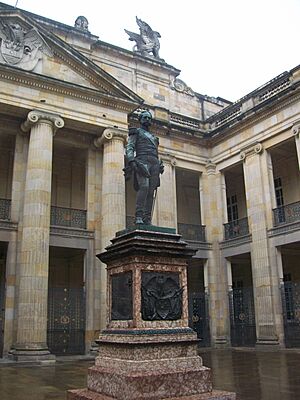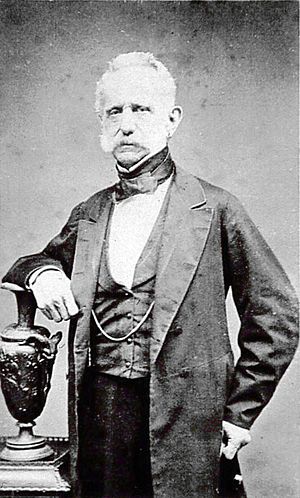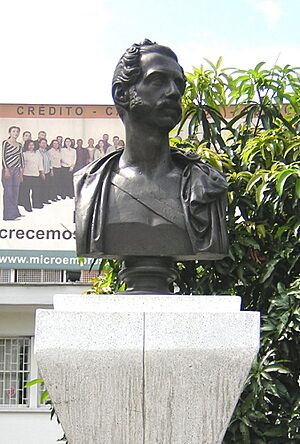Tomás Cipriano de Mosquera facts for kids
Quick facts for kids
Tomás Cipriano de Mosquera
|
|
|---|---|
 |
|
| 4th President of the United States of Colombia | |
| In office May 22, 1866 – November 1, 1867 |
|
| Preceded by | José María Rojas Garrido |
| Succeeded by | Joaquín Riascos |
| 1st President of the United States of Colombia | |
| In office May 14, 1863 – April 8, 1864 |
|
| Preceded by | Office created |
| Succeeded by | Manuel Murillo Toro |
| 3rd President of the Granadine Confederation | |
| In office July 18, 1861 – February 4, 1863 |
|
| Preceded by | Bartolomé Calvo |
| Succeeded by | Office abolished |
| 4th President of the Republic of New Granada | |
| In office April 1, 1845 – April 1, 1849 |
|
| Vice President | Rufino Cuervo y Barreto |
| Preceded by | Pedro Alcántara Herrán Zaldúa |
| Succeeded by | José Hilario López |
| 5th President of the Sovereign State of Cauca | |
| In office August 15, 1871 – August 1, 1873 |
|
| Preceded by | Andrés Cerón Serrano |
| Succeeded by | Julián Trujillo Largacha |
| 1st President of the Sovereign State of Cauca | |
| In office January 1858 – August 15, 1863 |
|
| Succeeded by | Eliseo Payán |
| Personal details | |
| Born |
Tomás Cipriano de Mosquera y Arboleda
September 26, 1798 Popayán, New Granada |
| Died | October 7, 1878 (aged 80) Puracé, Cauca, United States of Colombia |
| Nationality | Colombian |
| Political party | Liberal |
| Spouses | Mariana Arboleda y Arroyo (1820–1867) María Ignacia Arboleda Arboleda (1872–1878) |
| Relations | Joaquín de Mosquera (Brother) |
| Occupation | Soldier (General), writer, politician |
| Nickname | Mascachochas |
| Military service | |
| Allegiance | |
| Rank | General |
| Battles/wars | War of Independence War of the Supremes Ecuadorian-Colombian War |
Tomás Cipriano de Mosquera (born September 26, 1798 – died October 7, 1878) was an important Colombian general and politician. He served as president of Colombia four different times. His first term was as president of the Republic of New Granada from 1845 to 1849.
During the Colombian Civil War of 1860–1862, he led the Liberal forces. After the Liberals won, a new constitution was created. This constitution made the country a federal republic, meaning power was shared more locally. The nation was renamed the United States of Colombia. Mosquera then served two more times as president of this new government. He had a fourth term from 1866 to 1867. Many people consider him one of the most important figures in Colombian history of the 1800s because of the big changes he made.
Mosquera had a metal prosthesis in his jaw due to serious facial injuries from a battle in 1824. This made it hard for him to speak clearly. Some people made fun of him, calling him "Mascachochas," which meant "Gaga-chew."
Contents
Who Was Tomás Cipriano de Mosquera?
His Family Background
Tomás Cipriano de Mosquera was born in Popayán, Colombia, on September 26, 1798. His parents, José María de Mosquera-Figueroa y Arboleda and María Manuela de Arboleda y Arrachea, came from important and wealthy families. His brother, Joaquín, also became a president of Gran Colombia. Another brother, Manuel José, was an Archbishop in Bogotá, and Manuel María was a diplomat.
His Marriages and Children
General Tomás Cipriano de Mosquera was married twice. Both of his wives were relatives, which was common for wealthy families back then. His first wife was Mariana Benvenuta Arboleda Arroyo. After Mariana passed away, he married María Ignacia Arboleda Arboleda in 1872. Mosquera was 78 years old at the time. He had eight children in total from his marriages and other relationships.
His Academic Interests
Mosquera was a very smart person who taught himself many things. He was good at mathematics, history, and writing. He knew several languages, including Latin, English, French, and Italian. He wrote many books about philosophy and politics that are still respected today.
Mosquera's Military and Political Journey
Early Career and Rise to Power
By 1814, Mosquera was already involved in the movement for Colombia's independence. He served under the famous General Simón Bolívar. By 1824, he was a Lieutenant Colonel. In that year, he fought a battle against the Spanish Royalist Army in Barbacoas. It was in this battle that he was shot in the jaw, which caused his speech problems and led to his nickname "Mascachochas."
Because of his bravery in battle, he was promoted to colonel. He then became governor of several regions in the southwest of Colombia, like Buenaventura and Cauca. He continued to rise through the ranks and became a general in 1829.
Mosquera also worked as a diplomat, representing his country in Peru from 1829 to 1830, and later in various European countries and the United States from 1830 to 1833. When he returned to Colombia, he became a congressman (1834–1837). He later served as Secretary of War for the government of José Ignacio de Márquez. As Secretary of War, Mosquera led his forces to victory in the War of the Supremes in 1840. He was then sent as an ambassador to Peru, Chile, and Bolivia from 1842 to 1845.
First Time as President (1845–1849)
In 1845, Mosquera became president for the first time. During his time as president, he focused on opening up the country's economy. In 1846, his government signed an important agreement called the Mallarino–Bidlack Treaty with the United States. He also helped remove old colonial taxes and boosted the tobacco industry. It was during his presidency that the International System of Units (like meters and kilograms) was adopted in Colombia.
Mosquera also began to separate the government from the Catholic Church. He hired Thomas Reed to design and build the Capitolio Nacional, a very important government building. His government also conducted the first national census, counting the population. He also encouraged steamships to travel on the Magdalena River, which helped trade by allowing exports to pass through the port of Barranquilla.
Some of his policies were not popular with the groups who had supported him. He became closer to the Liberal party. After his term, he moved to New York City to work on his family's business. He later returned to Colombia to help stop a rebellion and defeat the rule of José María Melo in 1854. By then, he was a strong member of the Liberal party. He served as a representative and senator in Congress. He also ran for president again in 1857 but lost. When the Granadine Confederation was formed, Mosquera was elected president of the Cauca State. From this position, he opposed President Ospina, saying that Ospina was not respecting the states' independence.
The Civil War (1860–1862)

In 1860, Mosquera declared that the Cauca State was separating from the Granadine Confederation and started a war. He quickly gained support from other states. After many battles in the Colombian Civil War, Mosquera took control in 1861. After this, he helped create the United States of Colombia.
Second and Third Terms as President (1861–1864)
During his second term as president (1861–1863), Mosquera made several changes to reduce the power of the Catholic Church. He sold many church properties to help the economy and give land to poorer Colombians. He also banned Jesuits from the country because they openly supported the Conservative side.
Even with some disagreements, a new federal and liberal constitution was created. This constitution protected the rights of citizens and was supported by many leaders. It was decided that Mosquera would serve the first two-year term as President of the United States of Colombia, until April 1864.
His third term included a war with Ecuador in 1863. Mosquera personally led the Colombian army to victory. This was the only international conflict between these two countries at that time. After his term ended, he traveled to Paris to serve as an ambassador.
Fourth Term, Later Life, and Passing (1866–1878)
In 1866, Mosquera returned to Colombia and was elected president for the fourth time. However, there were tensions with the Catholic Church and he used strong measures, like closing Congress in 1867. This led to his opponents planning a coup d'état (a sudden overthrow of the government) on May 23, 1867. His enemies also knew that Mosquera planned to investigate officials who had misused public funds from church properties meant for the poor.
He was sent away from the country for three years and lived in Lima, Peru. While there, he wrote a book called 'Cosmogonía. Estudio sobre los diversos sistemas de la creación del universo' (Cosmogony. A study of the diverse systems of the creation of the universe). He came back to Colombia in 1871 and ran for president again but did not win. However, he was elected president of the Cauca State until 1873. He also served as a senator again in 1876.
Tomás Cipriano de Mosquera passed away on October 7, 1878, at his farm in Coconuco, near Popayán. He was buried in the Panteón de los Próceres cemetery in Popayán.
What Books Did Mosquera Write?
- Vida de Bolívar ("Life of Bolívar," New York, 1853)
- Cosmogonía. Estudio sobre los diversos sistemas de la creación del universo ("Cosmogony. A study of the diverse systems of the creation of the universe," 1868)
- Memoria sobre geografía física y política de la Nueva Granada
|
See also
 In Spanish: Tomás Cipriano de Mosquera para niños
In Spanish: Tomás Cipriano de Mosquera para niños



